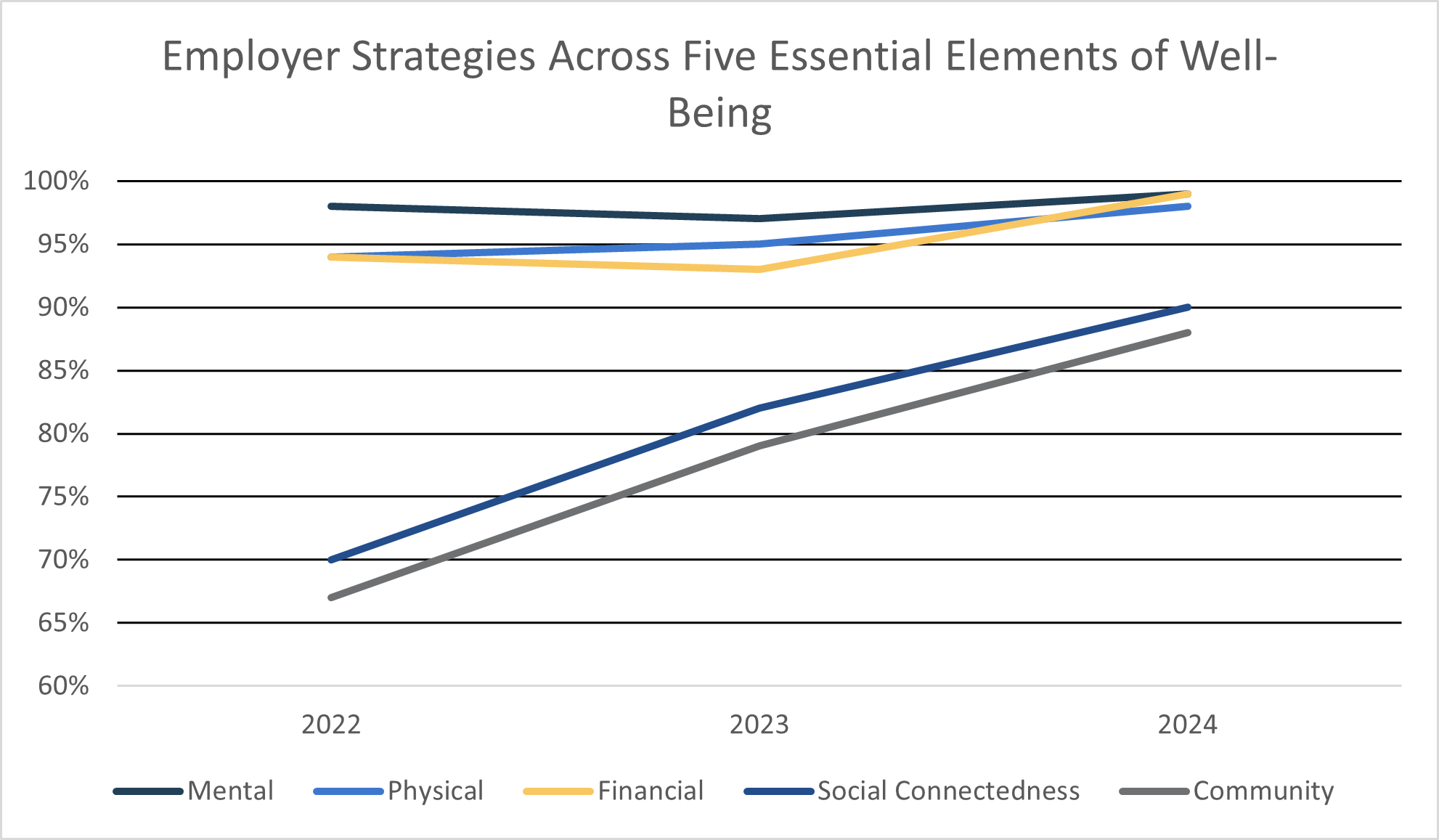This piece is co-authored by Jordana Choucair and Christopher Hart
Studies have shown that an employee’s health and happiness not only increases satisfaction, but also boosts productivity and supports talent retention. Armed with this knowledge, employers continue to develop and invest in new strategies and resources to better support employee well-being. These investments demonstrate that physical health is just one facet to “being healthy” as employers expand employee well-being programs to encompass a more holistic approach.
In 2010, Gallup published research that individuals’ personal sense of overall well-being is influenced by five inter-related dimensions: physical, social, financial, career, and community. Around the same time, the Business Group on Health and Fidelity Investments began surveying large employers about their well-being initiatives. Last year’s survey revealed that in the next three to five years, nearly all employers planned to either expand or maintain wellness initiatives and investments: 75 percent said they would increase their offerings and an additional 26 percent say they will maintain current efforts. This year’s survey, released in May, showed that employers were steadfast with that commitment. Despite economic pressures, employers continue to invest in well-being and nearly all employers’ well-being strategies include physical, mental, financial, social, and community.

Source: Business Group on Health and Fidelity Investments 14th Annual Employer-Sponsored Health and Well-being Survey. https://www.businessgrouphealth.org/en/resources/14th-annual-health-and-well-being-survey-2023 (N=184)
Why are these elements so important? Below, we have described each element and how employers design programs to support holistic employee well-being.
Mental Well-Being
Mental well-being is how a person feels about themselves and functions with others, in addition to their ability to successfully handle life’s stresses and adapt to change and difficult times. While mental well-being was not explicitly stated as one of the initial five essential elements, Gallup researchers Tom Rath and Jim Harter alluded to it with “Purpose” – the idea that each day should be spent doing something personally meaningful that could contribute to life goals. As illustrated by Figure 1 and discussed in a previous Third Horizon Strategies blog on employer investments in mental health care, employers have been steadily investing in mental health programs; however, the COVID-19 pandemic triggered a rapid increase in demand. Lyra Health’s State of Workforce Mental Health Survey found that 84 percent of the 1,000-plus workers surveyed said “robust and comprehensive” mental health benefits were an important factor when considering a new job.
Furthermore, last year, the World Health Organization (WHO) called on companies to promote workers’ mental health and well-being. Employers are responding by enhancing their mental well-being benefits and taking measures to help managers identify those needing services. For example, Willis Towers Watson found that 44 percent of employers offer manager training, such as general mental health awareness or training on identification of warning signs of mental distress and appropriate interventions, and another 30 percent are planning or considering the training in the next two years. Additionally, two of three U.S. employers indicate they plan to make employee mental health one of their top three health priorities over the next three years. A 2022 Employee Wellness Industry Trends Report found that 76 percent of employers were increasing investment in stress management and resilience programs, and 71 percent were increasing investment in mindfulness and meditation programs.
Physical Well-Being
Physical well-being is the ability to perform daily activities without undue fatigue or pain and take measures to prevent illness and injury. Because of the interrelated nature of well-being, physical well-being impacts the other essential elements and vice versa: maintaining good health helps you feel better mentally, engage socially, and perform well at work and in the community. The federal government began incentivizing employers to start offering health insurance to workers in the 1940s, and by the mid-1960s, employer-provided health insurance was almost universal. In the 1990s, employers began rewarding employees who completed the requirements of a healthy lifestyle activity, enrolled in healthy lifestyle activities, achieved certain cholesterol levels, stopped smoking, or controlled their weight. While some of those programs are still used today, employers have shifted their focus toward programs that empower those with chronic conditions to care for their health, help employees detect an underlying condition (e.g., diabetes or high blood pressure) through regular health screenings and assessments, and offer on-site fitness activities and classes. According to the Business Group on Health Survey, 50 percent of employers plan to invest more in physical health initiatives in the next three to five years. Three fastest-growing incentives for physical well-being in 2024 include digestive health, cancer, and musculoskeletal programs. While there is a potential role for “incentivizing well-being” to help individuals and loved ones access needed resources, we strongly believe that all employer well-being efforts should be focused on sustaining healthy lifestyle practices. This behavioral adoption does not manifest itself, over the long-term, through incentives. It is derived from the support systems that provide encouragement and meaningful interactions that contribute to personal enhancements in one’s life.
Want more daily health intelligence from Third Horizon Strategies? Sign up for Tea Leaves – a free daily newsletter capturing a rundown of the most important health industry activity!
Financial Well-Being
Financial well-being means a person can fully meet current and ongoing financial obligations, can feel secure in their financial future, and can make choices that allow them to enjoy life and contribute to feelings of life satisfaction. Higher food, housing, and goods and services costs have fueled employees to become more concerned about economic factors. According to the PwC 2021 Employee Financial Well-being Survey, finances were the top cause of employee stress above their job, their health, and their relationships combined. A separate global report released this year found that over half of respondents (56 percent) were worried about their financial futures and cited economic factors as their top concern. While many employers offer financial incentives to reward well-being, certain incentives tend to be offered for those already inclined to participate in available activities, creating a gap between the benefits employers offer and what employees actually need. For example, employees cited that subsidized food, transportation, or housing; financial wellness and planning tools; funding spending accounts to bring certain kinds of purchases (e.g., fitness, solar panels, ergonomic equipment) within reach; and assistance with travel expenses for health services not offered in my geographic area would be helpful.
Social Well-Being
Social well-being is building and maintaining healthy relationships, having meaningful interactions, and feeling a sense of belonging. Supportive relationships at work are associated with lower psychological distress and reduced workplace stress. They also help foster an environment of mutual respect, inclusion, and trust among peers. With the rise of remote and virtual working arrangements, more employees are experiencing social isolation, prompting employers to act. Ninety percent of employers plan to focus on social connectedness in 2024, up from 82 percent in 2023 and 70 percent in 2022. More employers also recognize how personal support networks can nurture healthy behavior and lifestyle changes. Eighty-one percent specifically plan to offer support networks in 2024, a 16 percent increase compared to 2023. In addition to support networks, employers have created designated areas for employees to socialize, connected different departments, encouraged team-building activities (e.g., office trivia, book clubs, sports teams, etc.), implemented programs to address loneliness/isolation, and continued to offer flexible work arrangements so employees can maintain work/life harmony and have healthy relationships outside of work.
Community Well-Being
Community well-being is the combination of social, economic, environmental, cultural, and political conditions identified by individuals and their communities as essential to feeling a sense of belonging, fulfill their potential, and flourishing. Seventy-nine percent of employers plan to focus on community well-being this year, up from 67 percent in 2022. Additionally, 74 percent plan to implement programs and tools to support community social needs in 2024, a 22 percent increase above 2023. Employers can support community well-being by offering time off to volunteer, hosting individual and/or team volunteer opportunities, making donations and donations matching by employees, developing and circulating communications to encourage community action, and publishing community impact analytics.
Conclusion
Organizations recognize that supporting individual employee well-being is strategically important for overall organizational health. Well-being investments help ensure that all employees feel connected and are empowered to thrive physically, mentally, financially, socially, and with their community, enabling employees to bring their best selves to work. Moving forward, employers will continue demonstrating their commitment to holistic well-being by enhancing programs and introducing personalized approaches that support diverse personal pathways to well-being and ultimately help individuals identify the resources and behavioral activities that will help them be well personally—inside and outside the company. Check back in September for part two of our blog, where we will offer thoughts on how employers can best approach investments in well-being benefits, programs, and resources.

